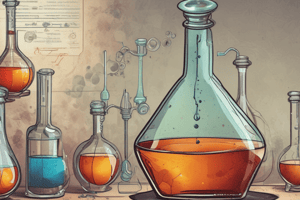Podcast
Questions and Answers
What is a significant difference in the physical properties of alcohols and ethers?
What is a significant difference in the physical properties of alcohols and ethers?
- Ethers form hydrogen bonds with water.
- Alcohols and ethers have the same boiling point.
- Ethers have a higher boiling point due to hydrogen bonding.
- Alcohols are more soluble in water due to hydrogen bonding. (correct)
Which statement about the preparation of alcohols is accurate?
Which statement about the preparation of alcohols is accurate?
- The hydration of alkenes involves the addition of water to a double bond. (correct)
- Reduction of ketones is not a method for preparing alcohol.
- Alcohols cannot be formed from the reduction of aldehydes.
- Alcohols are formed from carbon dioxide directly.
What rule is followed during the hydration of alkenes to form alcohols?
What rule is followed during the hydration of alkenes to form alcohols?
- Raoult's law
- Le Chatelier's principle
- Markovnikov's rule (correct)
- Hess's law
Why do alcohols and phenols exhibit higher boiling points compared to ethers?
Why do alcohols and phenols exhibit higher boiling points compared to ethers?
Which compound is an example of an alcohol based on the provided structural formulas?
Which compound is an example of an alcohol based on the provided structural formulas?
What is the main distinguishing feature of alcohols compared to phenols?
What is the main distinguishing feature of alcohols compared to phenols?
Which of the following statements about naming higher alcohols is true?
Which of the following statements about naming higher alcohols is true?
In the classification of alcohols, which of the following is an example of a tertiary alcohol?
In the classification of alcohols, which of the following is an example of a tertiary alcohol?
Which of the following compounds would be classified as a phenol?
Which of the following compounds would be classified as a phenol?
What is the common name for the alcohol with the formula CH3CH2CH2CH2OH?
What is the common name for the alcohol with the formula CH3CH2CH2CH2OH?
Flashcards
Alcohol
Alcohol
An organic compound containing an -OH group attached to an alkyl group. It's characterized by the presence of a hydroxyl group bonded to a carbon atom in an aliphatic chain.
Phenol
Phenol
An organic compound containing an -OH group attached to an aromatic ring. It is a type of alcohol with the -OH group directly bonded to a benzene ring.
Primary Alcohol
Primary Alcohol
An alcohol with the -OH group attached to a primary carbon atom. A primary carbon atom is directly connected to only one other carbon atom.
Secondary Alcohol
Secondary Alcohol
Signup and view all the flashcards
Tertiary Alcohol
Tertiary Alcohol
Signup and view all the flashcards
Ether
Ether
Signup and view all the flashcards
Hydrogen Bonding
Hydrogen Bonding
Signup and view all the flashcards
Markownikoff's Rule
Markownikoff's Rule
Signup and view all the flashcards
Reduction of Carbonyl Compounds
Reduction of Carbonyl Compounds
Signup and view all the flashcards
Study Notes
Alcohols and Phenols
- Alcohols and phenols are characterized by the presence of an OH group.
- If the OH group is attached to an alkyl group, it's called an alcohol.
- If the OH group is attached to an aromatic system, it's called a phenol.
- Alcohols and phenols are classified and named based on the structure of the alkyl or aryl group attached to the OH group.
- Primary alcohols have the structure R-CH₂OH.
- Secondary alcohols have the structure R₁-CH-OH-R₂.
- Tertiary alcohols have the structure R₁-C-OH-R₂-R₃.
Classification and Naming of Alcohols and Phenols
- Naming follows specific rules for multiple groups or structures
- IUPAC (International Union of Pure and Applied Chemistry) rules are used for naming alcohols containing more than five carbons.
Application to Biochemistry
- Blood sugar (glucose) contains five alcohol groups.
Physical Properties
- Alcohols and ethers are isomers with the same molecular formula.
- The boiling point of alcohols and phenols is higher than ethers due to hydrogen bonding.
Solubility
- Alcohols and phenols are soluble in water.
- Ethers are insoluble in water.
Preparation of Alcohols
- Hydration of alkenes: acid-catalyzed addition of water to an alkene.
- Reduction of carbonyl compounds: the addition of hydrogen to the carbon-oxygen double bond in aldehydes or ketones is called reduction, using catalysts.
- Example: using platinum
- Using Lithium Aluminum Hydride (LiAlH₄) is another method for reducing carbonyl compounds.
Reaction of Alcohols
- Dehydration: alcohols react with sulfuric acid to eliminate a water molecule, forming an alkene.
- Oxidation: oxidation depends on the structure
- Primary alcohols can be oxidized to aldehydes and then to carboxylic acids.
- Secondary alcohols are oxidized to ketones.
- Tertiary alcohols do not readily oxidize,
Ester Formation
- Alcohols react with carboxylic acids in the presence of a strong acid catalyst to form esters.
Oxidation of Alcohols in Living Systems
- Oxidation reactions are important in living systems and are catalyzed by enzymes called dehydrogenases.
- An example is the oxidation of malate to oxaloacetate.
- The reactions often involve nicotinamide derivatives (e.g., NAD+).
Studying That Suits You
Use AI to generate personalized quizzes and flashcards to suit your learning preferences.




